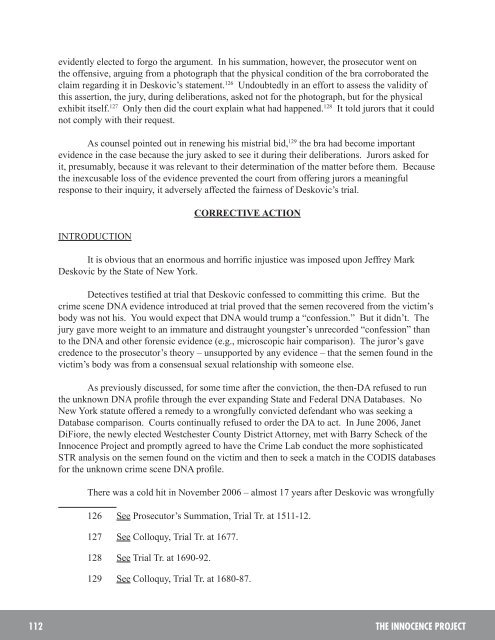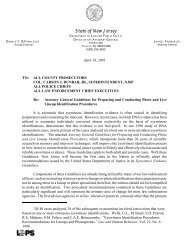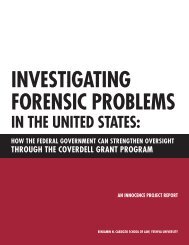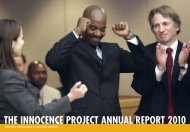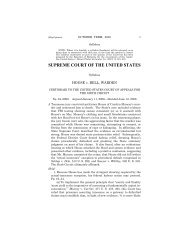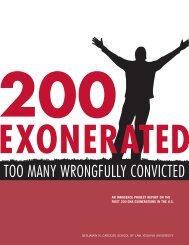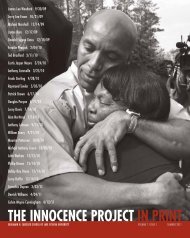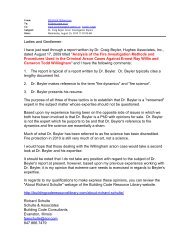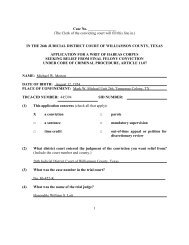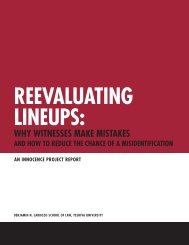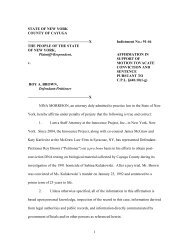Lessons Not Learned - The Innocence Project
Lessons Not Learned - The Innocence Project
Lessons Not Learned - The Innocence Project
You also want an ePaper? Increase the reach of your titles
YUMPU automatically turns print PDFs into web optimized ePapers that Google loves.
evidently elected to forgo the argument. In his summation, however, the prosecutor went on<br />
the offensive, arguing from a photograph that the physical condition of the bra corroborated the<br />
claim regarding it in Deskovic’s statement. 126 Undoubtedly in an effort to assess the validity of<br />
this assertion, the jury, during deliberations, asked not for the photograph, but for the physical<br />
exhibit itself. 127 Only then did the court explain what had happened. 128 It told jurors that it could<br />
not comply with their request.<br />
As counsel pointed out in renewing his mistrial bid, 129 the bra had become important<br />
evidence in the case because the jury asked to see it during their deliberations. Jurors asked for<br />
it, presumably, because it was relevant to their determination of the matter before them. Because<br />
the inexcusable loss of the evidence prevented the court from offering jurors a meaningful<br />
response to their inquiry, it adversely affected the fairness of Deskovic’s trial.<br />
INTRODUCTION<br />
CORRECTIVE ACTION<br />
It is obvious that an enormous and horrific injustice was imposed upon Jeffrey Mark<br />
Deskovic by the State of New York.<br />
Detectives testified at trial that Deskovic confessed to committing this crime. But the<br />
crime scene DNA evidence introduced at trial proved that the semen recovered from the victim’s<br />
body was not his. You would expect that DNA would trump a “confession.” But it didn’t. <strong>The</strong><br />
jury gave more weight to an immature and distraught youngster’s unrecorded “confession” than<br />
to the DNA and other forensic evidence (e.g., microscopic hair comparison). <strong>The</strong> juror’s gave<br />
credence to the prosecutor’s theory – unsupported by any evidence – that the semen found in the<br />
victim’s body was from a consensual sexual relationship with someone else.<br />
As previously discussed, for some time after the conviction, the then-DA refused to run<br />
the unknown DNA profile through the ever expanding State and Federal DNA Databases. No<br />
New York statute offered a remedy to a wrongfully convicted defendant who was seeking a<br />
Database comparison. Courts continually refused to order the DA to act. In June 2006, Janet<br />
DiFiore, the newly elected Westchester County District Attorney, met with Barry Scheck of the<br />
<strong>Innocence</strong> <strong>Project</strong> and promptly agreed to have the Crime Lab conduct the more sophisticated<br />
STR analysis on the semen found on the victim and then to seek a match in the CODIS databases<br />
for the unknown crime scene DNA profile.<br />
<strong>The</strong>re was a cold hit in November 2006 – almost 17 years after Deskovic was wrongfully<br />
126 See Prosecutor’s Summation, Trial Tr. at 1511-12.<br />
127 See Colloquy, Trial Tr. at 1677.<br />
128 See Trial Tr. at 1690-92.<br />
129 See Colloquy, Trial Tr. at 1680-87.<br />
112 THe InnoCenCe PRoJeCT


